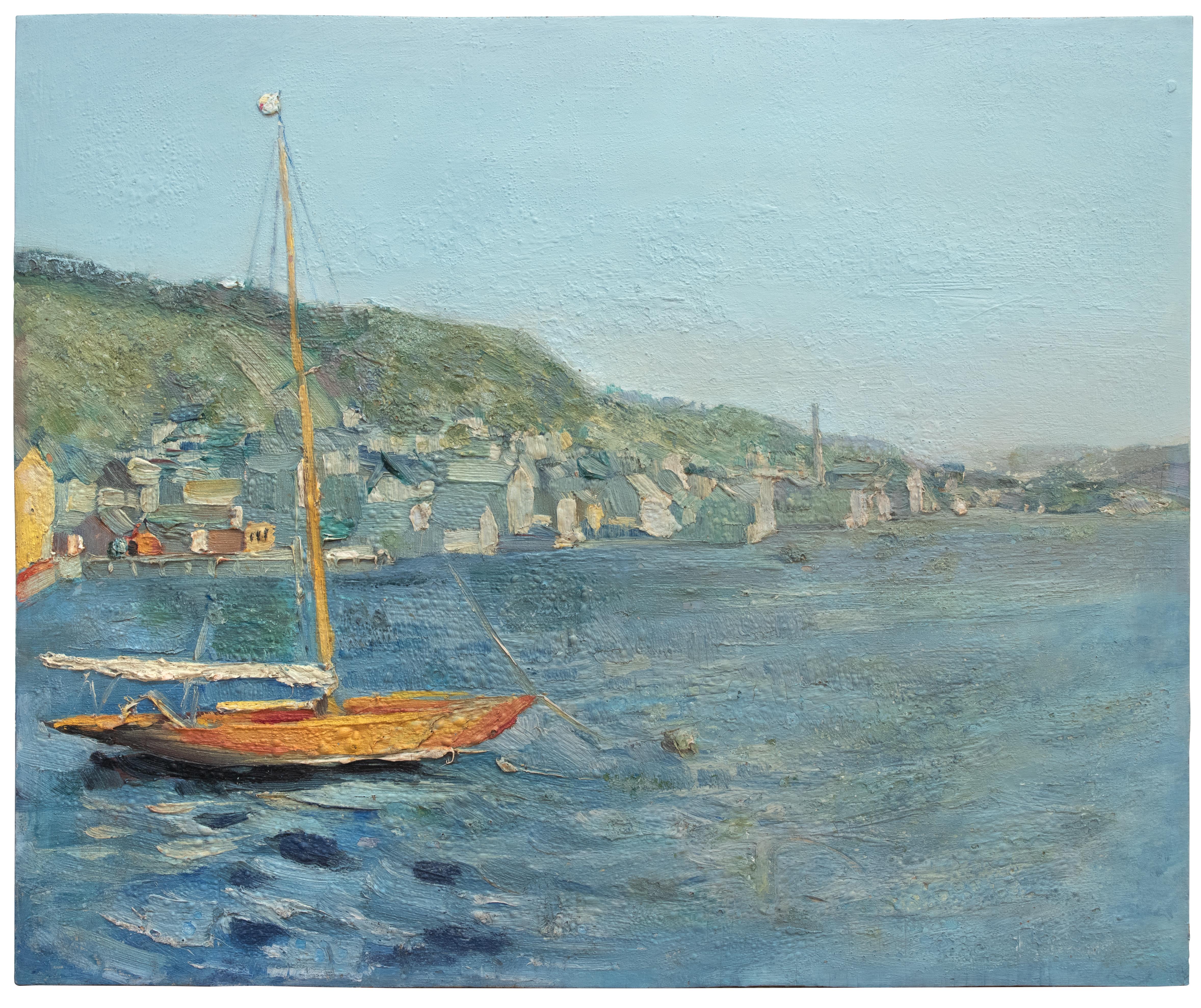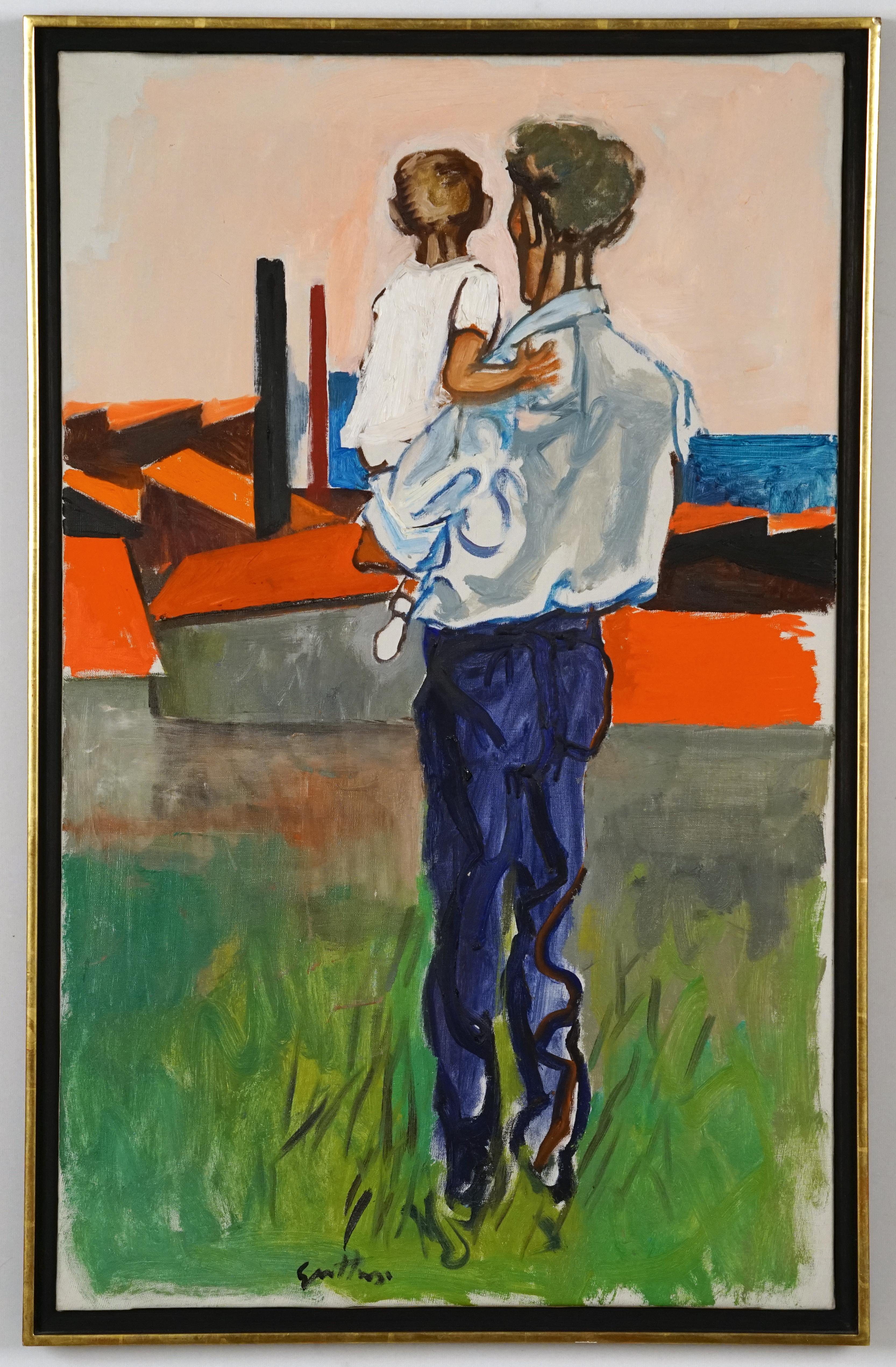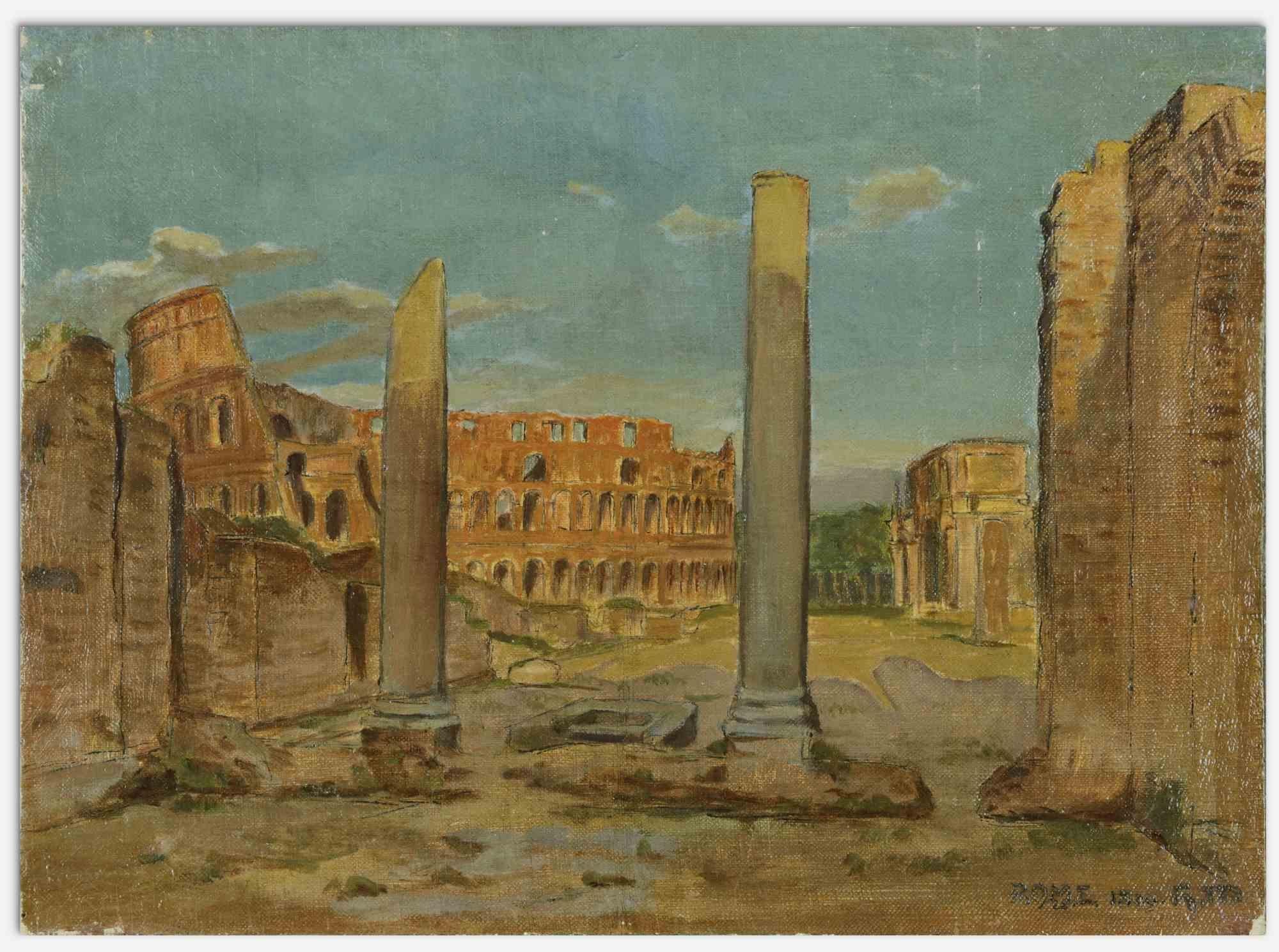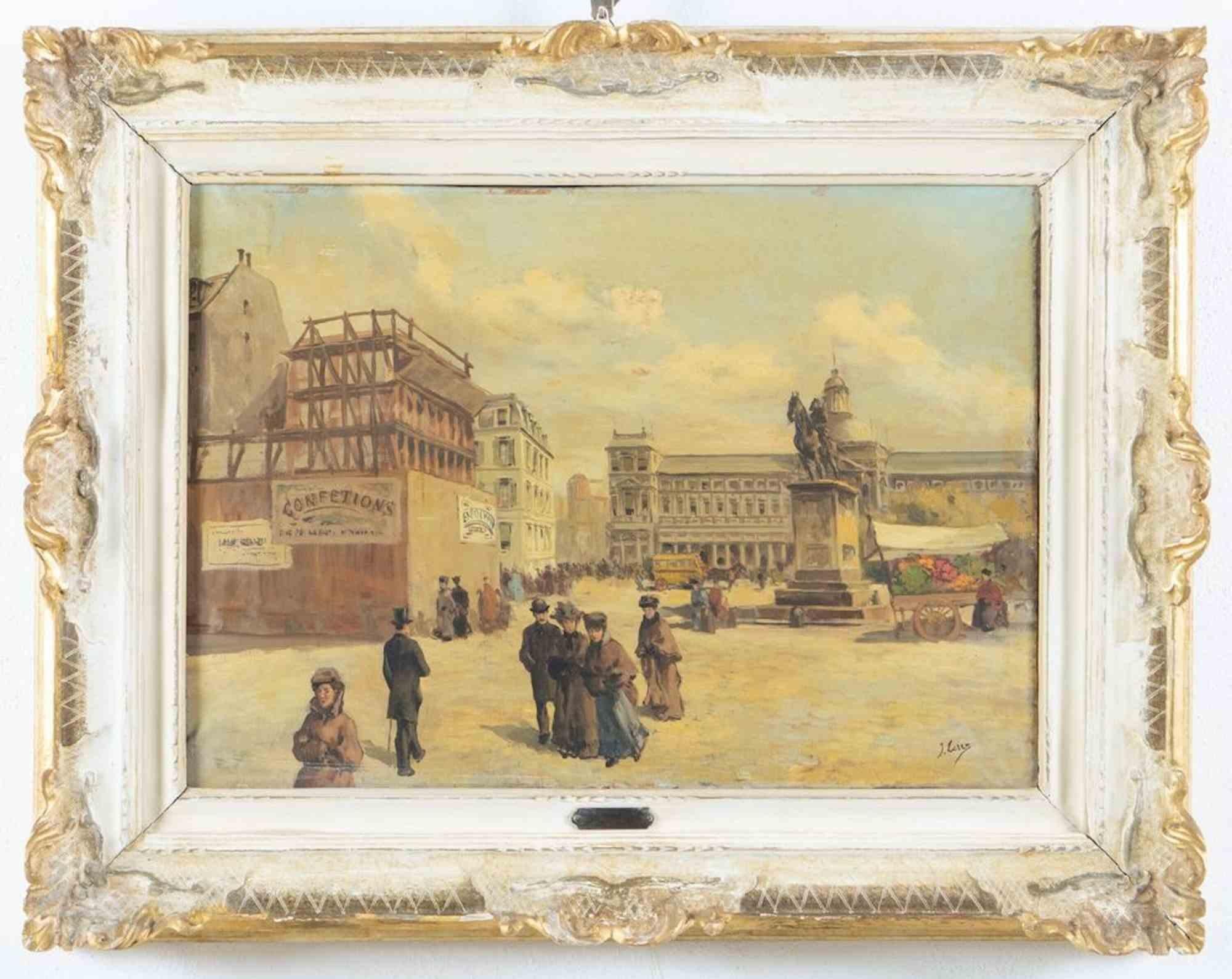Items Similar to Fauvist Israeli Landscape, Going to Synagogue Judaica Oil Painting
Want more images or videos?
Request additional images or videos from the seller
1 of 7
Melitta SchifferFauvist Israeli Landscape, Going to Synagogue Judaica Oil Painting
About the Item
Melitta Schiffer, painter. b. Trieste, Italy. In her youth, moved to Weimar, Germany with her parents.
Studied at Art Academy, Weimar, Germany;
Advanced studies with artist Mildan;
1935 - first solo exhibition at the Jewish Museum in Berlin;
1951 - studied in Europe.
Exhibited at the Israeli Club in Paris.
Upon her arrival to Israel, she became part of the country's art life, displaying her work in general and one-man exhibitions in art galleries and museums in most towns in Israel.
Lived in Haifa.
One of the first members of the Artists’ Village, Ein Hod.
She studied at The Academy there for 5 years, and in 1919, the Weimar academy of arts became the Bauhaus, the philosophy of which is known and distinctive to this day. She graduated from the school with the degree of "MEISTER" from the top class.
In 1921 she met Michael Schiffer, to whom she got married, and moved with him to nearby Jena , a famous University town in Thuringia, Germany. There her two children were born. She became a well known painter in that part of Germany. With the ascent of Hitler in 1933 the family had to flee to Palestine (now Israel) in 1936 but on the way they had to stay for half a year in Berlin until they got their papers. In that year, 1936 Melitta held an exhibition in the Jewish Community Center, which at that time was still operating. She received warm reviews in the press.
After her "Aliya " she settled in Haifa, Israel.
Melitta was soon accepted by the Association of Painters and Sculptors in Israel.
Mellita had many exhibitions and sold innumerous painting, which to this day adorn many homes in Israel.
In the 50's the famous painter and one of the founders of the DADA movement in art, Marcel Janco, founded the artist village EIN HOD which Melitta joined from the beginning. There she found a degree of fulfillment of the "Bauhaus" philosophy, of the dialog between artists of different disciplines, workshops, a joint gallery, Bazars and an active social life.
Melitta Schiffer lived and painted for many years. She had an extremely positive personality, and nearly anybody who met her felt an immediate feeling of rapport and friendship that flowed from her character.
On her 90th birthday the Haifa municipality arranged a exhibition for her in the foyer of the municipal auditorium, which was a great success.
She passed away on the 5th of October 1991, after a long and fruitful life.
- Creator:Melitta Schiffer (1900, Italian)
- Dimensions:Height: 19.25 in (48.9 cm)Width: 23.5 in (59.69 cm)
- Medium:
- Movement & Style:
- Period:
- Condition:Artwork in good condition, slight wear on frame.
- Gallery Location:Surfside, FL
- Reference Number:1stDibs: LU38212637682
About the Seller
4.9
Platinum Seller
These expertly vetted sellers are 1stDibs' most experienced sellers and are rated highest by our customers.
Established in 1995
1stDibs seller since 2014
1,559 sales on 1stDibs
Typical response time: 1 hour
- ShippingRetrieving quote...Ships From: Surfside, FL
- Return PolicyA return for this item may be initiated within 3 days of delivery.
More From This SellerView All
- Bathers at the Quarry 1940s American Modernist Oil Painting WPA eraBy Theresa Berney LoewLocated in Surfside, FLSwimmers and sun tanners at the local watering hole. Her birth name was Theresa Berney. At the time of her passing she was known as Theresa Loew. Birth place: Baltimore artist, blo...Category
1940s American Modern Landscape Paintings
MaterialsOil, Board
- 1930 Oil Painting Sea Side Sailboats American Modernist WPA Artist Morris KantorBy Morris KantorLocated in Surfside, FLMorris Kantor, American, 1896-1974 Seaside View, 1930 Hand signed M. Kantor and dated 1930 lower right Oil on canvas 22 1/4 x 19 1/4 inches 24 1/2 x 21 (frame) Morris Kantor (Belarusian: Морыс Кантор) (1896-1974) was a Russian Empire-born American painter based in the New York City area. This is a beautiful boat scene with a river or lake probably on Long Island. Born in Minsk on April 15, 1896, Kantor was brought to the United States in 1906 at age 10, in order to join his father who had previously relocated to the states. He made his home in West Nyack, New York for much of his life, and died there in 1974. He produced a prolific and diverse body of work, much of it in the form of paintings, which is distinguished by its stylistic variety over his long career. Perhaps his most widely recognized work is the iconic painting "Baseball At Night", which depicts an early night baseball game played under artificial electric light. Although he is best known for his paintings executed in a realistic manner, over the course of his life he also spent time working in styles such as Cubism and Futurism, (influenced by the Art Deco movement) and produced a number of abstract or non-figural works. A famous cubist, Futurist, painting of his "Orchestra" brought over 500,000$ at Christie's auction house in 2018. Kantor found employment in the Garment District upon his arrival in New York City, and was not able to begin formal art studies until 1916, when he began courses at the now-defunct Independent School of Art. He studied landscape painting with Homer Boss (1882-1956). In 1928, after returning to New York City from a year in Paris, Kantor developed a style in which he combined Realism with Fantasy, often taking the streets of New York as his subject matter. He did some moody Surrealist Nude paintings and fantasy scenes. In the 1940's he turned towards figural studies. Later in his career, Kantor himself was an instructor at the Cooper Union and also at the Art Students League of New York in the 1940s, and taught many pupils who later became famous artists in their own right, such as Knox Martin, Robert Rauschenberg, Sigmund Abeles and Susan Weil...Category
1930s American Modern Landscape Paintings
MaterialsCanvas, Oil
- Large Modernist Oil Painting 1940s, Judaica Hasidic Shtetl Wagon Driver WPA EraBy Emanuel Glicenstein RomanoLocated in Surfside, FLGenre: Modern Subject: Landscape with figure of horse, driver and wagon Medium: Oil Surface: wood Board EMANUEL ROMANO Rome, Italy, b. 1897, d. 1984 Emanuel Glicen Romano was born in Rome, September 23, 1897. His father Henryk Glicenstein was a sculptor and was living in Rome with his wife Helena (born Hirszenberg) when Emanuel was born. His father obtained Italian citizenship and adopted the name Enrico. Emanuel was brought up in Italy, Switzerland, Germany, England and Poland. In 1926 Emanuel Glicenstein Romano and his father sailed for New York. They briefly visited Chicago. Romano's sister, Beatrice, and mother only joined them in New York years later. Romano changed his name on his arrival to America and some have erroneously speculated that this was to avoid antisemitic discrimination. In truth, as the son of a highly-regarded artist, Romano changed his name to ensure that any success or recognition he would later attain, would be the result of nothing other than his own merit as an artist, and not on account of his father's fame. In 1936 Romano was worked for the WPA Federal Art Project creating murals. ( there were many jewish artists active with in the WPA period. notably Chaim Gross, Ben Shahn, Isaac and Moses Soyer, Abraham Rattner and many others. During and immediately after World War II, Romano created a series of allegorical works depicting graphic holocaust images that were held closely by the family until after his passing. One of these works is now on permanent display in the Florida Holocaust Museum in St. Petersburg Florida. Emanuel's father died in 1942 in a car accident before they could realize their shared dream of visiting Israel. In 1944 Romano, having completed his degree at the Pennsylvania Academy of Fine Arts and the Art Institute of Chicago, began teaching at the City College of New York. Romano moved to Safed, Israel in 1953 and established an art museum in his father's memory, the Glicenstein Museum. COLLECTIONS Indianapolis Museum of Art Metropolitan Museum of Art Boston Fine Arts Museum Fogg Museum Musée Nacional de France Recently his work has been added to the Florida Holocaust Museum collection. His notable works include his holocaust themed allegorical paintings as well as portraits of Marianne Moore, his father and William Carlos Williams...Category
1930s American Modern Figurative Paintings
MaterialsOil, Board
- San Francisco Cable Car WPA Artist Adolf Dehn Modernist Art Gouache Oil PaintingBy Adolf DehnLocated in Surfside, FLADOLF ARTHUR DEHN (American, 1895-1969) San Francisco Bay Area street scene, with Trolley, Streetcar, Cable Car with bay and Alcatraz Island in background. Hand signed LRC. Sight 19" x 15", overall 23" x 19". Adolf Dehn (November 22, 1895 – May 19, 1968) was an American artist known mainly as a lithographer. Throughout his artistic career, he participated in and helped define some important movements in American art, including regionalism, social realism, and caricature. A two-time recipient of the Guggenheim Fellowship, he was known for both his technical skills and his high-spirited, droll depictions of human foibles. Adolph Dehn was born in 1895 in Waterville, Minnesota. He began creating artwork at the age of six, and by the time of his death had created nearly 650 images. Dehn went to the Minneapolis School of Art (known today as the Minneapolis College of Art and Design), where he met and became a close friend of Wanda Gag. In 1917 he and Gág were two of only a dozen students in the country to earn a scholarship to the Art Students League of New York. He was drafted to serve in World War I in 1918, but declared himself a conscientious objector and spent four months in a guardhouse detention camp in Spartanburg, SC and then worked for eight months as a painting teacher at an arm rehabilitation hospital in Asheville, NC. Later, Dehn returned to the Art Students League for another year of study and created his first lithograph, The Harvest. In 1921 Dehn's lithographs were featured in his first exhibition at Weyhe Gallery in New York City. From 1920 to 1921 in Manhattan, he was connected to New York's politically left-leaning activists. In 1921, he went to Europe. In Paris and Vienna he belonged to a group of expatriate intellectuals and artists, including Andrée Ruellan, Gertrude Stein, and ee cummings...Category
1930s American Modern Figurative Paintings
MaterialsOil, Gouache
- Simka Simkhovitch WPA Artist Oil Painting Gouache American Modernist PowerlineBy Simka SimkhovitchLocated in Surfside, FLSimka Simkhovitch (Russian/American 1893 - 1949) This came with a small grouping from the artist's family, some were hand signed some were not. These were studies for larger paintings. Simka Simkhovitch (Симха Файбусович Симхович) (aka Simka Faibusovich Simkhovich) (Novozybkov, Russia May 21, 1885 O.S./June 2, 1885 N.S.—Greenwich, Connecticut February 25, 1949) was a Ukrainian-Russian Jewish artist and immigrant to the United States. He painted theater scenery in his early career and then had several showings in galleries in New York City. Winning Works Progress Administration (WPA) commissions in the 1930s, he completed murals for the post offices in Jackson, Mississippi and Beaufort, North Carolina. His works are in the permanent collections of the Dallas Museum of Art, the National Museum of American Art and the Whitney Museum of American Art. Born outside Kyiv (Petrograd Ukraine) into a Jewish family who owned a small department store. During a severe case of measles when he was seven, Simcha Simchovitch sketched the views outside his window and decided to become an artist, over his father's objections. Beginning in 1905, he studied at the Grekov Odessa Art School and upon completion of his studies in 1911 received a recommendation to be admitted to the Imperial Academy of Arts. Though he enrolled to begin classes in architecture, painting, and sculpture at the Imperial Academy, he was dropped from the school roster in December because of the quota on the number of Jewish students and drafted into the army. Simchovitch served as a private in the 175th Infantry Regiment Baturyn [ru] until his demobilization in 1912. Re-enrolling in the Imperial Academy, he audited classes. Simka Simkhovitch exhibited paintings and sculptures in 1918 as part of an exhibition of Jewish artists and in 1919 placed 1st in the competition "The Great Russian Revolution" with a painting called "Russian Revolution" which was hung in the State Museum of Revolution. In 1922, Simkha Simkhovitch exhibited at the International Book Fair in Florence (Italian: Fiera Internazionale del Libro di Firenze). In 1924, Simkhovitch came to the United States to make illustrations for Soviet textbooks and decided to immigrate instead. Initially he supported himself by doing commercial art and a few portrait commissions. In 1927, he was hired to paint a screen for a scene in the play "The Command to Love" by Fritz Gottwald and Rudolph Lothar which was playing at the Longacre Theatre on Broadway. Art dealers began clamoring for the screen and Simkhovitch began a career as a screen painter for the theater. Catching the attention of the screenwriter, Ernest Pascal, he worked as an illustrator for Pascal, who then introduced him to gallery owner, Marie Sterner. Simkhovitch's works appeared at the Marie Sterner Gallery beginning with a 1927 exhibit and were repeated the following year. Simkhovitch had an exhibit in 1929 at Sterner's on circus paintings. In 1931, he held a showing of works at the Helen Hackett Gallery, in New York City and later that same year he was one of the featured artists of a special exhibit in San Francisco at the California Palace of the Legion of Honor in Lincoln Park. The exhibit was coordinated by Marie Sterner and included four watercolors, including one titled "Nudes". He is of the generation of Russian Soviet artists such as Isaac Pailes, Serge Charchoune, Marc Chagall, Chana Orloff, Isaac Ilyich Levitan, and Ossip Zadkine. In 1936, Simkhovitch was selected to complete the mural for the WPA Post office project in Jackson, Mississippi. The mural was hung in the post office and courthouse in 1938 depicted a plantation theme. Painted on the wall behind the judge’s bench, “Pursuits of Life in Mississippi”, a depiction of black workers engaged in manual labor amid scenes of white professionals and socialites, was eventually covered over in later years during renovations due to its stereotypical African American imagery. Simka painted what he thought was typical of Jackson. His impression of pre-civil rights Mississippi was evidently Greek Revival column houses, weeping willow trees, working class families, and the oppression of African Americans. He painted African American men picking cotton, while a white man took account of the harvest and a white judge advised a white family, calling it Pursuits of Life in Mississippi. Though clearly endorsed by the government and initially generally well-received, the mural soon raised concerns with locals as the climate toward racial segregation began to change. The main concern was whether depictions that show African Americans in subjugated societal roles should be featured in a courtroom. The following year, his painting "Holiday" won praise at an exhibition in Lincoln, Nebraska. In 1940, Simkhovitch's second WPA post office project was completed when four murals, "The Cape Lookout Lighthouse and the Orville W. Mail Boat", "The Wreck of the Crissie Wright", "Sand Ponies" and "Canada Geese" were installed in Beaufort, North Carolina. The works were commissioned in 1938 and did not generate the controversy that the Jackson mural had. The main mural is "The Wreck of the Crissie Wright" and depicts a shipwreck which had occurred in Beaufort in 1866. "The Cape Lookout Lighthouse and the Orville W. Mail Boat" depicted the lighthouse built in 1859 and the mail boat that was running mail during the time which Simkhovitch was there. The boat ran mail for the area until 1957. "Sand Ponies" shows the wild horses common to the North Carolina barrier islands and "Canada Geese" showed the importance of hunting and fishing in the area. All four murals were restored in the 1990s by Elisabeth Speight, daughter of two other WPA muralists, Francis Speight...Category
1930s American Modern Landscape Paintings
MaterialsGouache, Oil, Board
- King David, Jerusalem (after Marc Chagall) Oil Painting Israeli Judaica ArtBy Zammy SteynovitzLocated in Surfside, FLFramed 41.5 x 29.5 image 35.5 x 23.5 This large painting depicts a man and woman, Adam and Eve, interlocked and embracing one another. The woman holds an enticing apple as they are thrusted from the Garden of Eden. This is an original painting. Zamy Steynovitz was born in Liegnitz Poland, in 1951. He immigrated to Israel in 1957. The aspiration to be a painter stems from his childhood and before leaving Poland, he won the first prize in an art competition for children. Zamy was formally educated at the Art School in Tel-Aviv and at the Royal Academy of London. Upon completing his studies, Zamy earnestly pursued his career and establish his place in the art world by displaying his work in one man exhibits and arts fairs around the world. His art displays chromatic and thematic richness and his choice of subjects has been strongly influenced by Jewish tradition, his Eastern European Jewish heritage and folklore. Zamy’s popular themes include Paris cafes, still-life, flowers, circuses and landscapes. Circus with acrobats and Harlequin. In the early stages of his career, he was partial to rich pastels and light brush strokes. In the early 1980s, Zamy visited South America, where the new surroundings enhanced his work with local brightness and color. His art gained chromatic power and his palette became richer in tones as the textures became thicker and the background darker and more colorful. These changes coupled with his thematic persistence allowed him to develop into a sensitive and mature artist. Zamy expresses a universal humanistic vision in his creations: man’s connection to his heritage and physical surroundings, two imperative aspects of our lives that should be heralded during these estranged technological times. As a result of his devotion to world peace, Zamy is known in the circles of the Nobel Institute for Peace in Norway. He is acquainted with many Nobel Prize winners including Anwar Sadat, Menachem Begin, the Dalai Lama, Itzhak Rabin, Shimon Peres, Elie Wiesel, Desmond Tutu and Oscar Arias, the ex-President of Costa Rica, along with many other politicians and artists. Zamy tragically passed away in September 2000. Exhibitions One Man Show 1970 - Museum - Ramat - Gan 1973 - Brussels - Gallery L'Angle Aigu 1974 - London - International Gallery 1974 - Paris - Grand Palais Gallery 1975 - Milan - Brera Gallery 1976 - N.Y. Valentino Gallery - N.Y. Hilton 1977 - N.Y. Valentino Gallery - N.Y. Hilton 1978 - Basel - Actual Gallery 1978 - Geneve - Bohren Gallery 1978 - Oslo - Nobel Peace Prize Exhibit 1979 - London - Hamilton Gallery 1979 - N.Y. - Art Israel Kalt - Waldinger Gallery 1979 - N.Y. - Canty Art Gallery 1979 - Amsterdam - Schipper Gallery 1979 - Washington - International Art Fair 1980 - Cleveland -Jewish Museum 1980 - Tel-Aviv - Habima National Art Fair 1981 - Abraham - Goodman House N.Y. 1981 - San Lucas Galley - Bogota 1982 - Pedro Gerson Gallery - Mexico City 1983 - Simon Bolivar...Category
20th Century Modern Figurative Paintings
MaterialsCanvas, Oil
You May Also Like
- Landscape - Oil Painting by Kurt Schwitters - 1936By Kurt SchwittersLocated in Roma, ITLandscape is a modern artwork realized by Kurt Schwitters in 1936. Mixed colored oil on canvas. Signed with monogram and dated on the lower right rec...Category
1930s Modern Figurative Paintings
MaterialsOil
- Father & ChildBy Renato GuttusoLocated in Sheffield, MARenato Guttuso Italian 1911-1987 Father & Child Oil on canvas 30 ½ by 19 in. W/frame 31 ½ in. by 20 in. Signed verso "Guttuso" Signed lower center "Guttuso" Dated 1966 Titled vers...Category
1960s Modern Figurative Paintings
MaterialsOil
- Mountain Landscape - Oil Painting by Antonio Feltrinelli - 1920sBy Antonio FeltrinelliLocated in Roma, ITMountain Landscape is an orignal modern artwork realized by Antonio Feltrinelli in 1920s. Mixed colored oil painting on canvas. Not signed. Antonio Feltrinelli (Milan, 1887 – Garg...Category
1920s Modern Figurative Paintings
MaterialsOil, Canvas
- Landscape - Oil Painting by Attilio Pratella- Early 20th CenturyBy Attilio PratellaLocated in Roma, ITLandscape is an original modern artwork realized by Attilio Pratella in the early 20th Century. Oil painting on board. Includes frame. Handwritten notes on the back Good conditionsCategory
Early 20th Century Modern Figurative Paintings
MaterialsOil
- Imperial Forums and Coliseum on the Background - Oil Paint - 1899Located in Roma, ITImperial Forums and Coliseum on the background is an artwork realized in 1899. Mixed colored oil painting on canvas. Titled and date on the lower margin. Unreadable monogram. Good...Category
1890s Modern Landscape Paintings
MaterialsOil
- Vieille France - Painting by Jean Lereu - 19th CenturyLocated in Roma, ITVieielle France is an original oil painting on canvas realized by Jean Lereu, in the late 19th century. Hand-signed in the lower right margin. 49.5x69 cm with frame. Good condit...Category
19th Century Modern Figurative Paintings
MaterialsOil, Canvas





